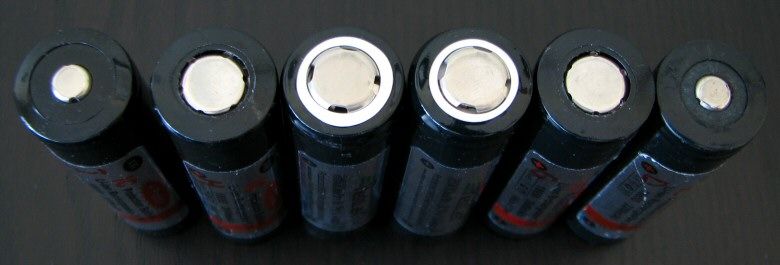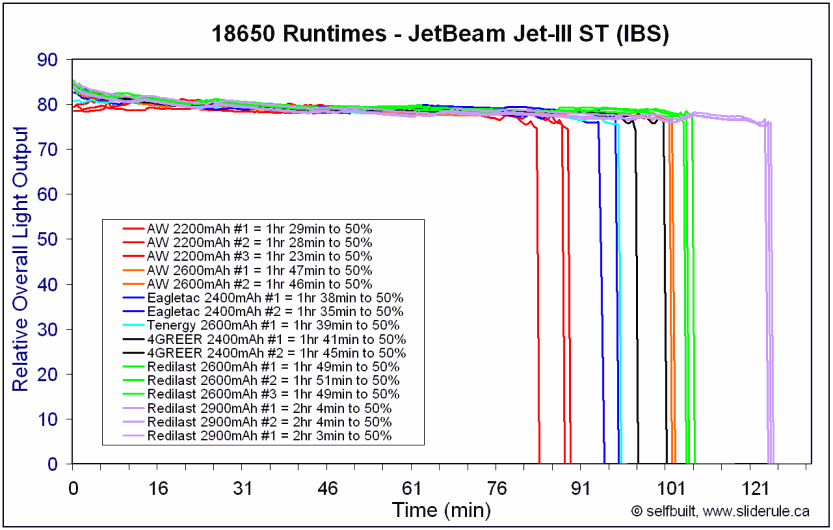I have recently been sent a number of Redilast batteries for review. I know this brand is are already well-known here, but here is my quick mini-review of the 2600mAh and 2900mAh protected 18650 cells

(sorry for the reflections, those are shiny labels! )
)
Note that this mini-review will be done somewhat in the style of my Quick CR123A and AA Battery Shoot-out Comparison, and will include a number of protected 18650 cells in my possession. Most of the other batteries will likely be familiar to CPFers. Also note that I am not going to be cutting up any batteries here :sweat: – I'm simply going to compare the apparent capacities in my standard test bed.
To start, the batteries:


From left to right, AW 2200mAh, AW 2600mAH, Redilast 2600mAh, Redilast 2900mAh, AW 2600mAh, AW 2200mAh.
The purpose of the above is to show you the height and button-top differences of the Redilast compared to the standard AW cells. The older AW 2200mAh cells (which have the classic button-top) are shorter than these newer high-capacity cells. The AW 2600mAh cells have flat-tops that don't project beyond the wrapping, although they do have points on the bottom to help with contact when in series.
In contrast, both the Redilast 2600mAh and 2900mAh have a raised top, although this is wider than the classic button-top. The 2900mAh seems a touch taller as well (scroll down for actual measures).
Here are some additional cells to be used in the runtime tests:

From left to right, AW 2200mAh, AW 2600mAh, Tenergy 2600mAh, Eagletac 2400mAh, 4GREER 2400mAh.
Note that the rated capacities are directly from the manufacturer, as printed on the batteries.
And now the average weights and heights of all of the above:
Testing Method:
My standard test bed for all Li-ion batteries is the original JetBeam IBS circuit. I possess the first-generation IBS circuit in all three body types (Jet-I, Jet-II and Jet-III), which allows me to similarly compare 14500, 16340 (RCR), 14670, 17670, and 18650. I like using this circuit for comparison testing because it is optimized for 3.7V Li-ion, reasonably heavily driven at max output, and runs fully-regulated.
To test batteries, I charge up each new battery I receive on my Pila and then run on the appropriate IBS light at 100% until the protection circuit kicks in. This gives me an easy way to estimate the capacity of new cells as they arrive (as well as periodically monitor their health over time). FYI, in my standard reviews, I only use "typically" performing AW 18650 2200mAh button-top cells (i.e. cells that perform around the average of all samples I have bought).
Results:

First off, notice that there is generally good consistency among multiple samples from a given manufacturer (i.e. not too much variability). Also, cells with higher rated capacities typically do better, as you would expect.
The Redilast batteries were remarkably consistent among the 3 samples for each class. The 2600mAh cells were very good performers – all 3 samples slightly outlasted my 2 AW 2600mAh cells, as well my 4GREER 2400mAh cells (which perform closer to 2600mAh).
The Redilast 2900mAh cells definitely pulled away from the pack. As with the Redilast 2600mAh cells, the runtime performance was excellent.
Again, I don't know what the internal construction of the cells are like, but my Redilast samples seem of consistent and good quality in their external presentation (i.e. no bulging contact surfaces, centered raised-tops, etc.). I also note that a useful summary sheet on Li-ion safety and function was included with the cells. :thumbsup:
Hope you found the runtime comparisons useful!
:wave:
----
Redilast batteries were provided by Redilast/Tactical HID for review.

(sorry for the reflections, those are shiny labels!
Note that this mini-review will be done somewhat in the style of my Quick CR123A and AA Battery Shoot-out Comparison, and will include a number of protected 18650 cells in my possession. Most of the other batteries will likely be familiar to CPFers. Also note that I am not going to be cutting up any batteries here :sweat: – I'm simply going to compare the apparent capacities in my standard test bed.
To start, the batteries:


From left to right, AW 2200mAh, AW 2600mAH, Redilast 2600mAh, Redilast 2900mAh, AW 2600mAh, AW 2200mAh.
The purpose of the above is to show you the height and button-top differences of the Redilast compared to the standard AW cells. The older AW 2200mAh cells (which have the classic button-top) are shorter than these newer high-capacity cells. The AW 2600mAh cells have flat-tops that don't project beyond the wrapping, although they do have points on the bottom to help with contact when in series.
In contrast, both the Redilast 2600mAh and 2900mAh have a raised top, although this is wider than the classic button-top. The 2900mAh seems a touch taller as well (scroll down for actual measures).
Here are some additional cells to be used in the runtime tests:

From left to right, AW 2200mAh, AW 2600mAh, Tenergy 2600mAh, Eagletac 2400mAh, 4GREER 2400mAh.
Note that the rated capacities are directly from the manufacturer, as printed on the batteries.
And now the average weights and heights of all of the above:
- AW 18650 2200mAh button-top – 45.9g, 67.4mm
- AW 18650 2600mAh flat-top – 46.4g, 67.8mm
- Tenergy 2600mAh button-top – 45.8g, 67.2mm
- EagleTac 2400mAh button-top – 46.7g, 68.8mm
- 4GREER 2400mAh button-top - 48.6g, 69.2mm
- Redilast 2600mAh raised-top – 47.2g, 68.5mm
- Redilast 2900mAh raised-top – 45.7g, 68.9mm
Testing Method:
My standard test bed for all Li-ion batteries is the original JetBeam IBS circuit. I possess the first-generation IBS circuit in all three body types (Jet-I, Jet-II and Jet-III), which allows me to similarly compare 14500, 16340 (RCR), 14670, 17670, and 18650. I like using this circuit for comparison testing because it is optimized for 3.7V Li-ion, reasonably heavily driven at max output, and runs fully-regulated.
To test batteries, I charge up each new battery I receive on my Pila and then run on the appropriate IBS light at 100% until the protection circuit kicks in. This gives me an easy way to estimate the capacity of new cells as they arrive (as well as periodically monitor their health over time). FYI, in my standard reviews, I only use "typically" performing AW 18650 2200mAh button-top cells (i.e. cells that perform around the average of all samples I have bought).
Results:

First off, notice that there is generally good consistency among multiple samples from a given manufacturer (i.e. not too much variability). Also, cells with higher rated capacities typically do better, as you would expect.
The Redilast batteries were remarkably consistent among the 3 samples for each class. The 2600mAh cells were very good performers – all 3 samples slightly outlasted my 2 AW 2600mAh cells, as well my 4GREER 2400mAh cells (which perform closer to 2600mAh).
The Redilast 2900mAh cells definitely pulled away from the pack. As with the Redilast 2600mAh cells, the runtime performance was excellent.
Again, I don't know what the internal construction of the cells are like, but my Redilast samples seem of consistent and good quality in their external presentation (i.e. no bulging contact surfaces, centered raised-tops, etc.). I also note that a useful summary sheet on Li-ion safety and function was included with the cells. :thumbsup:
Hope you found the runtime comparisons useful!
:wave:
----
Redilast batteries were provided by Redilast/Tactical HID for review.
Last edited:

